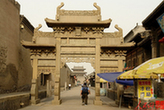Three major structures of the altar, namely the Circular Mound Altar (huanqiu), the Imperial Vault of Heaven (huangqiongyu) and the Hall of Prayer for Good Harvests (qiniandian) all have round floors and roofs, in accordance with the concept of round Heaven. Deep-blue tiles were chosen to cover these structures so as to harmonize with the blue sky.
The Circular Mound Altar, also known as the Altar for Worshiping Heaven (Baitiantai) or the Sacrificial Altar (Jitai), is the place where the emperor worshiped Heaven at the winter solstice. The Imperial Vault of Heaven is the place where the tablets of the gods were kept, surrounded by a circular wall of polished bricks, known as Echo Wall (huiyinbi), where a person whispering close to the wall at any point can be heard distinctly at any other point along the wall.
In the northern part of the temple, the Hall of Prayer for Good Harvests is a lofty, round structure with triple eaves and a cone-shaped blue-tile roof crowned with a gilded knob. When the hall was built in 1420, the colors of the triple eaves, from top to bottom, were blue, yellow and green, representing the God of Heaven, the emperor, and the common people. In 1752, all the eaves were painted blue. The hall burned down in 1889 after being struck by lightning. It was reconstructed in 1890 and renovated in 1970.
The ceiling of the Hall of Prayer for Good Harvests is painted with an exquisite design of nine dragons, and is supported by 28 wooden columns. The four central columns, called the Dragon-Well Columns, represent the four seasons. They are surrounded by two rings, one inside the other, of 12 columns each. The inner ring symbolizes the 12 months of the year, and the outer, the 12 divisions of day and night according to the old Chinese way of reckoning time. Every year, the emperor led civil and military officials to the hall and prayed for good harvests.
Designed with distinctive compactness and exquisiteness, and decorated magnificently, the Temple of Heaven is a building complex of a beauty rare even among the sacrificial buildings in China and a valuable part of the architectural heritage of the world.
Sacrificial Culture
Sacrifices to Heaven were arranged in winter every year. On the 15th day of the first lunar month, on the winter solstice (22nd solar term), and some time during the first month of summer, the emperor would go to the Temple of Heaven to worship Heaven, to pray for good harvests and rainfall, and to offer sacrifices to the ancestors, to the gods of the sun, the moon and the stars, and to the gods of the clouds, wind, rain, and thunder and lightning.
Sacrificial ceremonies followed complex procedures. First, the whole altar area had to be renewed from end to end, including the roads to be taken by the emperor. Second, the sacrifices, including oxen, goats, piglets, fruits, etc., had to be properly prepared and displayed in front of seven groups of spirit tablets. In addition, 700-odd items of utensils and other sacrificial facilities, as well as more than 60 musical instruments of 16 kinds, including bells and chimes, had to be placed in order. Third, one day before the formal ceremony, the emperor was obliged to burn joss sticks in the Imperial Vault of Heaven, to check the spirit tablets in the Circular Mound Altar, to examine the sacrifices in the sacred kitchen, and to begin fasting in the Palace of Abstinence.
The ceremony began before sunrise. The emperor proceeded from the Palace of Abstinence, amid the sound of bells, to the Circular Mound Altar, when drums and other instruments took the place of the bells. At the formal opening of the sacrificial ceremony, oxen were roasted, lanterns were raised, and a mystical aura would soon cloak the scene. The whole ceremony was divided into nine procedures -- from receiving the Heavenly King to seeing Him off. Different music would accompany different parts of the ceremony.
Every sacrificial ceremony was a grand occasion to solicit welfare for the country, as well as respect and awe from the people towards the emperor, who was sanctified as the Son of Heaven (Tianzi) throughout ages.





Why not rent a boyfriend, or girlfriend to please parents during the Spring Festival?